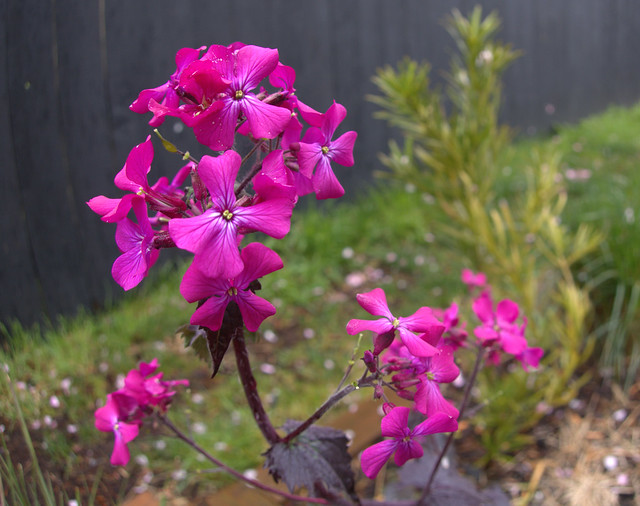In a very mossy, narrow bed against the Oregon house, north-facing, street-facing, this dark-leaved strain of honesty sown from seed was planted out last summer. Germination was quick and robust — I had dozens of seedlings. This spring these biennials in the back garden are spindly with a few leaves; the front garden honesty are tall and lush, an intensely purple sight so early in the season.
I can only surmise they prefer this sheltered, protected spot against the house. In between bouts of cutting back last season’s growth since we arrived April 5, cool and muddy work, I like to take frequent breaks to check on this little group of honesty that is having its best moment right now.
When we left in October 2024, the front garden honesty was making gorgeous, big-leaved carpets, and I’m sure I was thinking “Good luck holding on to those leaves over winter — see you in spring!’ I had no idea what to expect. (I wrote in August 2024: “This display of characterful leaves that’s extended all summer may be a one-off, so I’m hesitant to talk about them because I don’t fully understand what’s going on. They are carpeting the narrow border on the north side of the house. Lunaria is a biennial, so when these plants bloom next spring this show of leaves will be over. Somehow the timing of when I sowed and planted them resulted in big lush leaves all summer. It’s probably just a fluke that will be impossible to replicate.”)
Not only did they hold on to those impeccable leaves, the plants grew richer and deeper in color as well as tall and strong over a winter that saw winds rampageous enough to knock down a section of fence. (It seems we are perpetually building and repairing fences.)
As far as the garden overall, arriving a week earlier might have been preferable, because the growth on the grasses and perennials is already tall and strong. The camassias are tall and in bud, as are tulips in pots. After much hemming and hawing, I’ve removed the tetrapanax/rice paper plant. Stunning as those big leaves are, the roots are tunneling through the gravel and colonizing the stock tanks. The giant leaves provide shade where it’s not needed in a very small garden, and overall tetrapanax now scores more as nuisance than asset. (Your calculus may vary.) I’m sure that won’t be the end of this famously ineradicable plant, though, in either the north or south gardens. I’ve shuffled around a couple olearias and the sinopanax, and am happy to report that the Acacia pravissima sailed through winter — though not the Acacia cultriformis.
More fence work today, so Billie will be safe to wander the back garden. While her leg mends from surgery, there will be no romping with the very energetic labradors next-door who bark at Marty through the gap while he makes the repair. Fences make good dog neighbors too!







The Lunaria is a winner on all around! I tried growing something in that genus years ago here and, needless to say, it didn’t survive. I envy you the opportunity to grow plants entirely different from those that thrive in zone 10/11.
Our neighbor across the street in Portland had lunaria that came up every year. But hers were just the standard which she happily shared for drying. Yours are much more impressive!
I’m hopeful my Acacia pravissima has made it through winter in Astoria. We return there from CA in less than a month, and I know what will need attention for the first week, and likely beyond!
My Lunaria annua was purchased as one 4″ plant from Annies many years ago -I think the variety was ‘Rosemary Verey’ -very similar foliage to yours. Here it has to grow in the shade, so it’s a tad floppy but you can’t beat that foliage . I cut it back heavily in summer when it starts to look tattered and crispy -it invariably reseeds . This spring it has been particularly prolific, no doubt due to a nice rainy season -just under 30″- so there will be plenty of seedheads for the vase ! I actually saw a Tetrapanax for sale at a nursery on the central coast when I was down there last week. I talked myself out of it knowing what would likely be the result in my climate. Containing it would be futile !
The purple foliage is spectacular. I love this best of both worlds way of life you have, Oregon summers are so wonderful. I think Tetrapanax is gorgeous, but I’ve been too afraid of it’s heartiness to ever have it here.
Some of my garden friends have tried to push Tetrapanax onto me. No thanks! I don’t need a runner, I need gentle perambulators. Welcome back to Oregon. May your abandonment issues be forgotten in the onslaught of a hearty Oregon growing season.
This definitely a plant to search for. They do very well in my climate. I remember my mother always had a vase of the seed pods at the end of a hallway outside my bedroom. We called them silver dollars. I didn’t particularly like them but opinions do change.